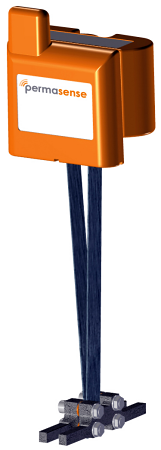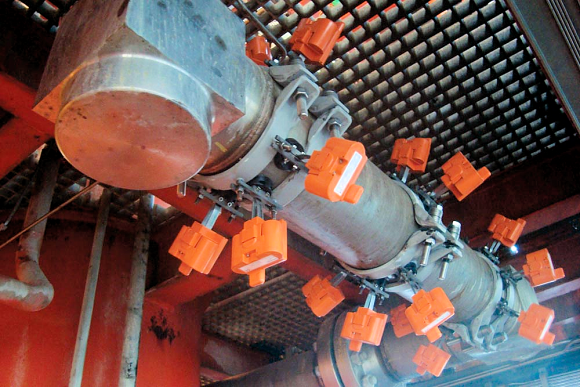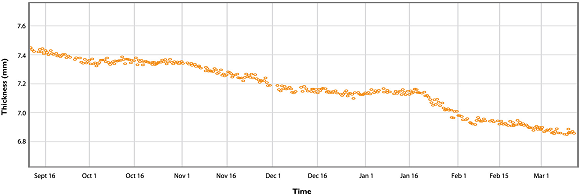
One of the major problems in the oil and gas industry is corrosion/erosion. While this is sometimes easy to see on the structural supports of offshore oil and gas platforms, the pipes and pipework are key components that also have this problem in a big way.
Internal corrosion occurs due to the corrosive fluids that exist throughout the industry from when the oil or gas is pulled out of the ground, transported to, and processed through the refinery. Erosion comes to gas production facilities in the form of abrasive sand that is produced with the gas that wears away at the pipes, particularly at the bends and junctions where the flow velocity is increased. The problem is that these forces eat away at the insides of the pipes and are not readily apparent from the outside, but over time pipe thickness is significantly reduced (see chart 1).
|
|
To try and combat this, refineries and other oil and gas facilities are required to undergo inspections, which often require a shutdown. With the vast sums of money spent in this industry on extraction and refining, it is understandable that to make money in this business, you have to keep everything running as much as possible. Shutdowns, while necessary, mean that the company is not making money. Worse still are shutdowns that have not been planned and occur due to unexpected problems.
One solution to these problems, UK company Permasense has developed an innovative sensor that uses ultrasonic waves to continually monitor the pipe thickness and to show rates of erosion and corrosion (see fig. 1). This allows for early detection of corrosion or erosion problems and gives operators time to implement mitigation strategies or for plans to be made on leveraging the facility's assets (pipework) to their maximum before a planned shutdown.

Fig.1: The Permasense sensor employs ultrasonic waves to continually monitor pipe thickness to warn of corrosion.
Additionally, the sensors are part of a system that feeds this pipe thickness and temperature data via a wireless signal to a receiver that delivers it to the facility operator's office. The system records the measurements over time and presents the information in a meaningful way to show rates of erosion and corrosion with the facility in service. This means that oil and gas wells and refineries can make better decisions on how to use their pipework assets before scheduled pipe change-outs.
For example, in a gas production facility where sand erosion can be a big problem, operators can decide to safely increase production rates while verifying that there is no increase in sand erosion rate and that there is plenty of pipe wall thickness left to ensure safe operation until the next scheduled shutdown.
For an oil refinery, operators may decide that if the pipe wall is getting too thin from corrosion, they can use special inhibitor chemicals to stabilize and minimize the rate of corrosion. The sensor data not only tells you that you need to mitigate the damage, such as using inhibitors, but also if the changes you make are effective in minimizing the rates that the metal is being lost. Alternatively, if corrosion is less than expected, it may be possible for the refinery to process more corrosive crude oils which are often available at discounted prices.
The sensors are battery-operated and have a battery life of up to 10 years. When the battery starts to get low, it is quick and easy to replace. The sensors have also been designed to work on pipes that operate in temperatures up to +1,100°F (+600°C) by separating the electronic part of the sensor from the hot pipe using stainless steel legs. The fact that the sensors are wireless and battery operated means that the sensors can be used in remote locations or hard to reach places, such as unmanned offshore platforms or places that normally require a shutdown or expensive scaffolding to access (see fig. 2).

Fig. 2: The battery-operated sensors can be placed in remote and/or difficult to access locations.
Corrosion and erosion are serious problems and, while these sensors don't stop corrosion, they are a necessary part of any integrity monitoring and mitigation program. Unplanned shutdowns due to corrosion problems are expensive and if and when it happens, replacing corroded pipework is the least of the operator's problems. Environmental impact, employee safety, opportunity costs for not being in production, all affect not only the bottom line, but also the reputation of the company.
About the Author
Dr. Jake Davies is the Marketing director at Permasense. He led the operational testing of the Permasense system at BP facilities from the outset, and subsequently Permasense's commercial deployment of the system at locations across the world. He has a deep understanding of ultrasonic physics with a track record of satisfying the needs of the diverse teams within oil & gas environments that play a role in specifying, installing and operating monitoring systems. Jake's earlier career with Guided Ultrasonics Ltd involved the successful commercial introduction of his doctoral research to the upstream Oil & Gas market. He holds a PhD from Imperial College London and an MEng from Oxford University.
Related Stories
Intelligent Flow Meter Market Worth $7098.79 Million by 2020
